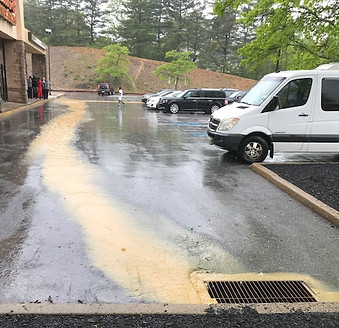Stormwater
Stormwater is rainwater or melted snow that runs off streets, lawns and other sites. When stormwater is absorbed into soil, it is filtered and ultimately replenishes aquifers or flows into streams and rivers.
Credit: Open Space Institute
You may have read about stormwater management in the paper or heard about stormwater ordinances at your local town meeting, but what exactly is it? Simply put, stormwater is water that falls to the earth as precipitation or melts from snow or ice. Depending on where it lands, this precipitation can either soak into the ground, evaporate into the atmosphere, or become runoff.
Have you ever looked outside when it is raining and seen stormwater flowing in the street? This happens because many of our modern land uses consist of man-made structures like houses, buildings, compacted lawns, and roads. These surfaces are known as impervious, meaning that liquids cannot pass through them. In natural environments like forests, the ground is pervious, meaning that precipitation can soak naturally into the soil and become groundwater.

Did you know that each year, an estimated 10 trillion gallons of untreated stormwater runoff enters US streams, rivers, and oceans from city sewer systems? The cause, believe it or not, is right above our heads and we don’t even see it! On average, a 1500 square foot roof can generate about 900 gallons of water in a 1” rainstorm. This runoff can run directly into the storm sewer system through a standpipe or indirectly by flowing onto impervious surfaces and into storm drains.

When stormwater can’t soak into the ground naturally, it needs to go somewhere else! This is where stormwater management, the process of controlling and directing runoff, comes into play. In built environments like cities, suburbs, and small towns, runoff flows into stormwater systems like storm drains and sewers or directly into surface waterways. Traditional or “gray” stormwater management is designed with the goal of directing water away from development as quickly as possible.
As stormwater makes its way to storm drains, it can pick up pollutants like motor oil, road salt, soil, fertilizer, and pesticides. Then, this water travels through our underground storm sewer system and enters untreated into local surface bodies like streams, rivers, lakes, etc. Stormwater runoff not only harms the quality of our water and the health of the organisms that live in it, but can also contribute to damaging floods during large storm events, especially in downstream communities.


Further, the lack of rainwater infiltration has a negative impact on groundwater supplies. Groundwater is a way the Earth creates water storage and is also where streams get their flow when it is not raining. The issues created by this altered system require unique solutions. These include a focus on greening our communities in a way that mimics the natural water cycle which occurred before modern human development. Check out our page on Green Stormwater Infrastructure to learn more about this approach!

(Credit: Philadelphia Water Department)
